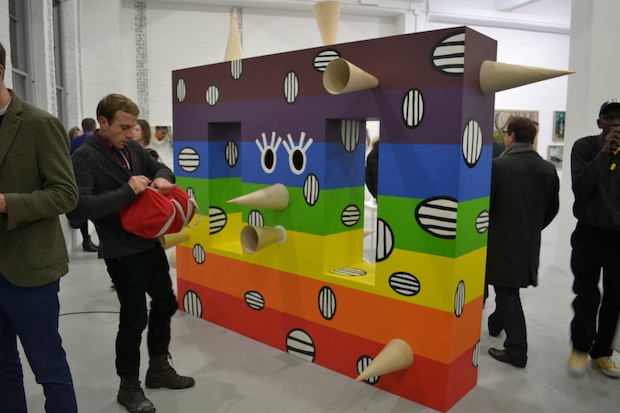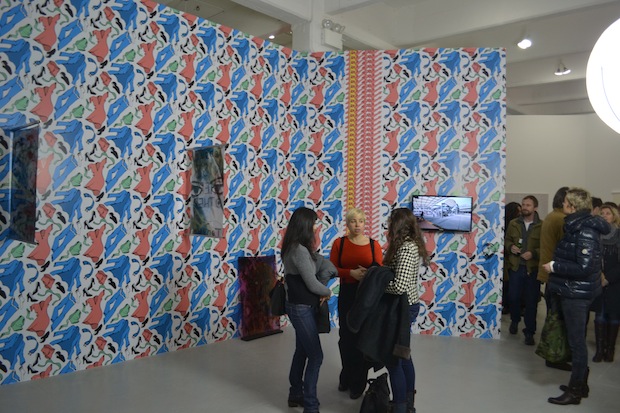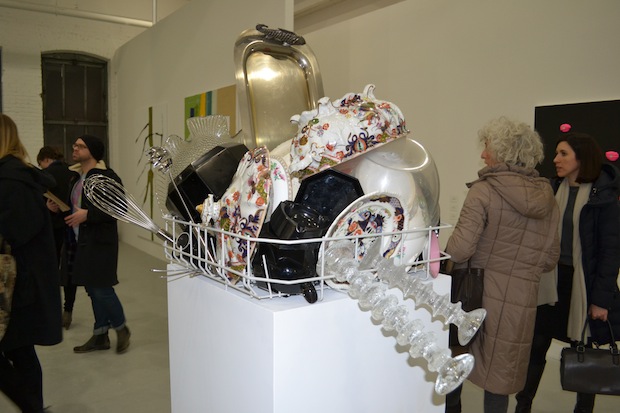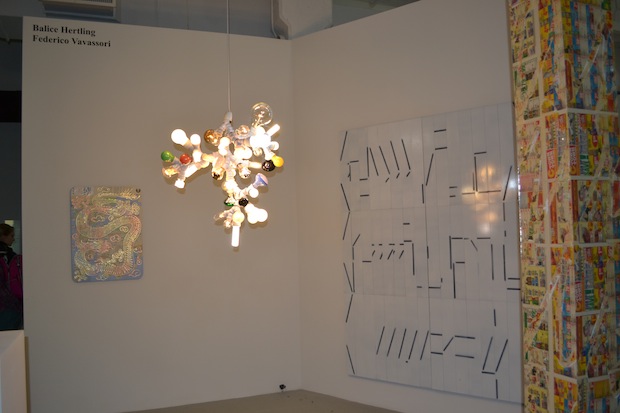In 2010, forty of New York’s up-and-coming galleries sailed downstream to avoid the Armory’s stench of death. Maybe it was the massive crowds or the lack of sunlight that made Thursday night’s opening so grim, but, four iterations later, the Independent has unmistakably assumed the mantle of young establishment.
This year’s fair has calcified digital minimalism and trash assemblage of the Contemporary Art Daily genre down to its elitist core; both this fair and NADA have been boiling that concoction down for the past four years, but it was formerly overlookable thanks to the occasional dash of humanity or wit. When, in 2011, a whole section was given over to John Smith’s contemplative Hotel Diaries series, it felt like the Independent might eventually provide a real alternative to the then-exhausting hustle of the Armory; now, those unprofitable moments have been studiously eliminated, perhaps out of fear they’d scare off the sort of people who confuse high fashion sheen with intellectual rigor.
People who only recently seemed innovative are represented here by the same homogeneous fair-ready paraphernalia: Ryan McNamara’s clothing sculptures, for example, are stripped. Galerie Neu is showing what looks like Ull Hohn’s mauve plaster “relief paintings,” a challenge to craftsmanship in the late 80s which, today, looks perfectly on-trend. Truly emerging artists are few and far between, with stacked decks typified by Maureen Paley’s booth of David Salle, Wolfgang Tillmans, Gillian Wearing, Liam Gillick, Thomas Eggerer, and Rebecca Warren. (We’re hard-pressed to think of a booth at the Armory—other than the big anchors of Lisson, Victoria Miro, Sean Kelly and Sprueth Magers—that brought so much wheat and so little chaff.)
Where other fairs—like Untitled, Spring/Break, and Seven—have fought against the mind-numbing repetition of the white cube, The Independent revels in it, hoping a few Y-shaped walls will hide the brutal, regressive minimalism it shares with Frieze, and the self-seriousness it shares with its Milan-based media partner, Mousse. The fair also ignores the recent turn towards curated fairs, like Untitled and the 2012 Armory’s strong Nordic Focus, which, at their best, tempt collectors into booths they might otherwise avoid or else set up works that are not fair-ready on their own.
By comparison, the Independent’s nod to curation—a symbolic $10,000 prize for outstanding curatorial work by an exhibitor—seems to have the opposite effect, homogenizing rather than diversifying. One gets the feeling that despite the fair’s 49 booths, there are really only about two breeds on offer: Gavin Brown and Maureen Paley. Everyone else is an imitator of varying degrees, slightly off the breed standard, and willing to groom their artists into oblivion to fix that. (Ultimately, curators Stefan Kalmar (of Artists Space) and Clarissa Dalymple decided to split the money equally between the participating non-profits: The Kitchen, Printed Matter, White Columns, and Glasgow International Festival of Visual Art).
For an observer, that makes the Independent a more than usually soul-crushing fair. For all the homogeneity of Basel, the Armory, or Frieze, there are bursts of energy, comedy, and drama, too: out-of-touch collectors buying out-of-touch art, desperate dealers with hail-mary installations from the uncool parts of Europe, funny contraptions to take a selfie with. The power plays are less Machiavelli and more Louis XIV, as when Gagosian buys the biggest booth and decorates only the walls.
There’s none of that here, which on its face seems like a good thing. After all, the fair isn’t doing anything wrong. The galleries are strong, and many present themselves better here than they do in their storefronts. If you are a moderately-to-severely overpaid creative professional who speaks two or more languages, you will almost certainly find a safe investment. Sales, by all accounts, are very good, and a number of big-name collectors and curators have showed up to go shopping for Kunsthalle-ready work. Dealers will be going home happy, because this is art dealing as science, and it’s almost perfect.
Slideshow, with commentary:
By the time you get to Gavin Brown’s booth on the fourth floor—deep in the fair’s heart of whiteness—the installation there looks downright casual. Once again, they’ve thrown up some silly wallpaper by Thomas Bayrle, and then covered it in B+ paintings of dicks made up of smaller dicks, hung in standard kunstellation style. Inasmuch as an art fair booth can, it feels like the end of Mean Girls: secure in her position as a Known Hottie, our Lindsay Lohan is suddenly possessed of the grace and personality to do something very slightly unexpected, tearing up the prom crown where a less confident queen would have paraded it around. Either that, or the gallery is just cunning enough to zig (again) when others zag.

Pissy onlookers at the Kitchen's booming Thursday night keyboard and poetry performance by Big Legs (Dan Fox and Mark Beasley). I walked through the same fart twice in this area, which didn't help warm up the crowd.

"The default exchange adjusted" at the Modern Institute. Joanne Tatham & Tom O'Sullivan have been making these things for several years. It's about emptiness.
Clothes, dishes, lightbulbs:

You have to hand it to Raebervon Stenglin for presenting "Life Gem," a contract and an empty stone setting that will be used to contain a diamond forged from the ashes of artist Jill Magid after she dies. I'm not sure if this a contemplation on death, or collecting for a name, or the artist's desire to get into a museum (she hopes it'll go to an institution), but the very real consequences have far more resonance than, say, a pile of fake money.











Comments on this entry are closed.